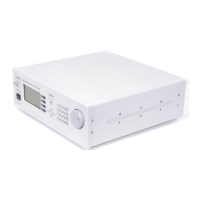50 Chapter 4 Temperature Controller Module Operation
The higher the gain, the more current will be driven for any given temperature
difference, with the maximum current being determined by the current limit.
The error voltage also drives an integrator. The integrator’s output also controls the
amount of current being driven through the TEC. The integrator is an amplifier
whose gain is proportional to time. The longer a given error voltage is present, the
more current will be driven through the TEC, with the maximum current being
determined by the current limit. The speed at which the integrator’s output increases
is the integration time, which can be “Slow” or “Fast”. Some TEC modules do not
support the Slow setting, and therefore omit the Fast designator in the range of
settings.
The allowed Gain values are: 0.2 Slow, 0.6 Slow, 1 Slow, 1 Fast, 2 Slow, 3 Fast, 5
Fast, 6 Slow, 10 Slow, 10 Fast, 20 Slow, 30 Fast, 50 Fast, 60 Slow, 100 Fast or 300
Fast. The number actually defines the proportional loop gain. The slow/fast suffix
indicates the speed at which the integrator’s output increases. The slow setting allows
for larger masses or greater distance between the sensor and the thermo-electric
cooler by slowing the speed of the integrator.
Both the proportional gain and the integration time must be matched to the thermal
characteristics of the TE cooler and sensor. If the settings are incorrect, the
temperature set point will take an excessive amount of time to settle, or it will
oscillate around the set point and never settle.
The Gain setting depends on the type of TE cooler that you are using, but we can
suggest guidelines for selecting the proper gain. Set the gain to 1 fast and increase it
until the actual temperature oscillates around the set temperature. Then reduce the
gain to the next lower value.
To read the Gain setting, go to the setup. The display will show the value of the Gain
setting. In Constant I
TE
mode the Gain setting has no effect.
4.4.3.3 C1, C2, C3, and Ro
See the section of each of the sensors for a description of how C1, C2, C3, and Ro
are used.
4.4.3.4 Mode
4.4.3.4.1 Constant Temperature Mode (Const T)
This mode holds the TEC at a constant temperature based on feedback from the
sensor in the TEC mount, using “
T
SET
=
” and “
T=
” variables. In this mode, the 8000
uses a control loop comparing the sensor input to the temperature set point, driving
the I
TE
current positive or negative to reach and maintain that set point. The sensor’s
input is converted to temperature for display of actual TEC temperature. The I
TE
current is also displayed in this mode.
Artisan Technology Group - Quality Instrumentation ... Guaranteed | (888) 88-SOURCE | www.artisantg.com

